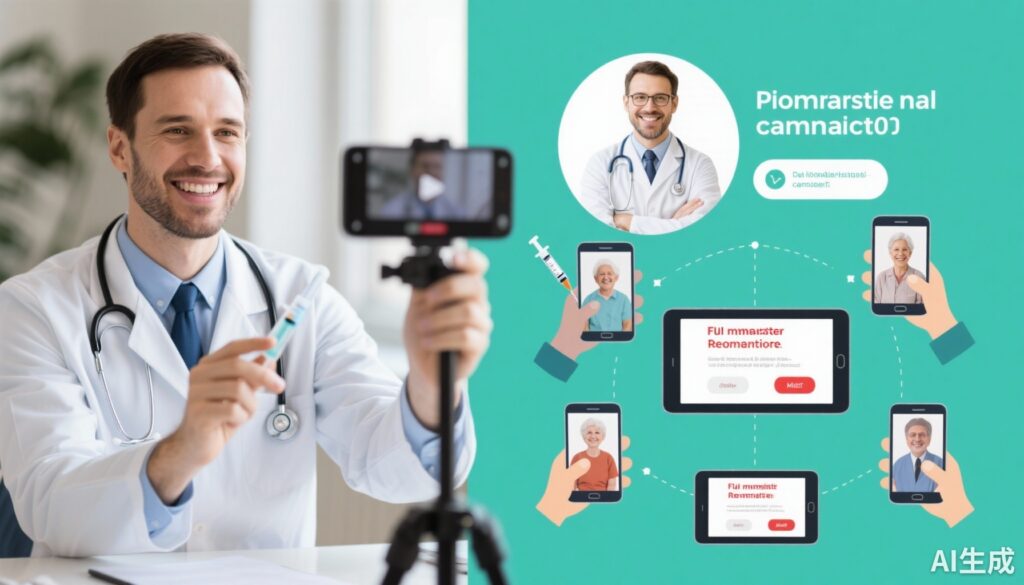Introduction
Influenza (flu) remains a significant public health challenge in the United States, with vaccination coverage persistently below optimal levels. Vaccine hesitancy, defined as delay in acceptance or refusal of vaccines despite availability, is a major barrier to increasing influenza immunization rates. Trusted healthcare professionals, especially primary care physicians, are key influencers in patient decisions about vaccination. Personalized communication strategies leveraging physician-patient relationships have the potential to enhance vaccine uptake.
This study aimed to investigate whether personalized video or infographic messages created by primary care physicians, featuring their photographs and messages encouraging influenza vaccination, could effectively increase vaccination rates in a diverse patient population across age groups at UCLA Health medical practices during the 2023-2024 flu season.
Study Design and Population
A randomized clinical trial with three parallel arms was conducted. Participants included patients aged 6 months and older, identified through electronic health records as unimmunized for influenza as of October 31, 2023. The patient cohort was served by 21 primary care physicians from 21 distinct practices affiliated with UCLA Health.
Patients under each physician’s care were randomized into one of three groups: (1) usual care with standard reminders; (2) receipt of a physician-created video promoting the flu vaccine; or (3) receipt of a physician-created infographic featuring a photo and a scripted message encouraging vaccination.
Videos were brief clips recorded by physicians using smartphones or video conferencing tools, incorporating a suggested script to promote vaccination. Infographics were visually engaging materials including the physician’s photograph and encouraging language similar to that used in the videos. Both communications were sent up to three times through the patient portal at monthly intervals (October, November, December 2023).
Outcomes Measured
The primary outcome was influenza vaccination status by April 1, 2024, marking the end of the flu season. A key secondary outcome was the timeliness of vaccination by December 31, 2023.
Analyses focused on the evaluable patient population — those confirmed to have been followed during the study period with adequate data capture.
Results
The study included 22,233 patients: 14.4% were children under 18, 66.1% were adults aged 18-64 years, and 19.5% were adults 65 years or older. Females comprised 62.8% of the population and 84.9% had private insurance.
By April 1, 2024, influenza vaccination rates were 46.9% in the usual care group (3,479 of 7,417), 48.0% in the video group (3,557 of 7,410), and 47.5% in the infographic group (3,518 of 7,406). Statistical analysis showed no significant differences between either intervention and usual care overall (adjusted risk ratio 1.03 for video, 1.02 for infographic).
However, post hoc subgroup analysis of children revealed significantly higher vaccination rates in both intervention arms compared to usual care by April 1, 2024: 58.4% in the video group (618 of 1,058), and 55.1% in the infographic group (598 of 1,085), versus 54.5% in usual care (576 of 1,057). This difference was statistically significant (P < .001 for video; P = .04 for infographic).
Discussion
While overall influenza vaccination rates did not increase significantly with personalized video or infographic interventions from physicians, the enhanced uptake observed among children is notable. This suggests that tailored communication directly from a trusted healthcare provider may be particularly effective in parental decision-making about vaccinating their children.
The lack of significant impact in the adult population indicates that vaccine hesitancy related to influenza may require broader or alternative strategies, including multifaceted interventions addressing individual beliefs, accessibility, and social influences.
Personalized messages harnessing the physician-patient relationship represent a promising tool, especially for pediatric populations. However, the complexity of adult vaccine hesitancy necessitates further innovation in messaging content, delivery methods, and possibly combining personalized communications with community engagement or behavioral nudges.
Limitations
The trial was conducted within a single healthcare system with a predominance of patients insured privately, potentially limiting generalizability to more diverse or underserved populations. Physicians created their own videos or infographics using a standard script, which could vary in quality or persuasiveness. Additionally, reliance on electronic health record data may miss vaccinations received outside the system.
Conclusions
In this randomized clinical trial at UCLA Health during the 2023-2024 influenza season, physician-personalized video and infographic messages did not significantly increase influenza vaccination rates overall by the end of the season. However, both interventions increased vaccination rates among children, suggesting the potential value of personalized physician messaging in pediatric vaccine promotion.
Future efforts to improve influenza vaccination rates across all age groups may benefit from incorporating personalized communication strategies with more comprehensive, culturally sensitive, and multi-level interventions.
Clinical Implications
Primary care providers remain central in promoting influenza vaccination. Personalized videos or infographics can be an effective adjunct, particularly for influencing parental decisions on childhood vaccines. Healthcare systems should consider integrating such tools within broader immunization campaigns to optimize reach and impact.
Trial Registration
ClinicalTrials.gov Identifier: NCT06062264.
Reference
Szilagyi PG, Clark EJ, Duru OK, Casillas A, Ong MK, Vangala S, Tseng CH, Albertin C, Humiston SG, Ross MK, Evans S, Kumar A, Chakarian I, Sloyan M, Fox CR, Rand CM, Lerner C. Video and Infographic Messages From Primary Care Physicians and Influenza Vaccination Rates: A Randomized Clinical Trial. JAMA Netw Open. 2025 Aug 1;8(8):e2526514. doi: 10.1001/jamanetworkopen.2025.26514. PMID: 40802184; PMCID: PMC12351418.



